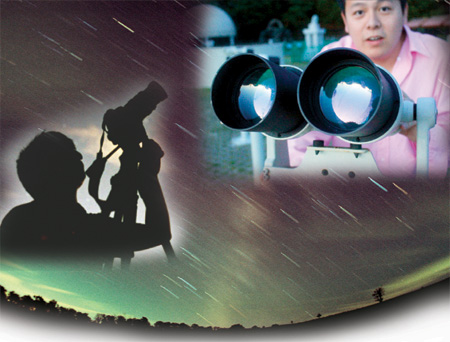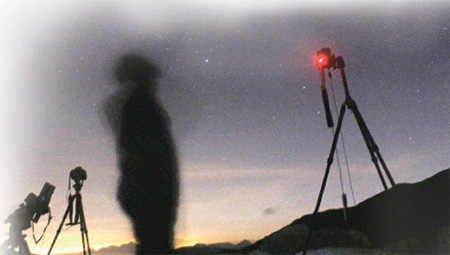Stargazers wish for shooting stars
Updated: 2010-08-17 07:05
By Doug Meigs(HK Edition)
|
|||||||||
|
The Hong Kong Space Museum install night viewing stations at the Astropark, a public "dark sky reserve" in Sai Kung East Country Park. Doug Meigs / for China Daily |
|
Hong Kong astronomy-lovers flock to the east dam of High Island Reservoir to view the Perseid meteor shower on Friday morning. Doug Meigs / for China Daily |
Local stargazers battle light pollution, air pollution and unpredictable weather to view the ongoing Perseid meteor shower. Doug Meigs reports.
Fireballs and shooting stars (aka meteorites) trace the skies over Hong Kong. The show begins after midnight and continues until dawn. On Friday morning, amateur astronomers counted nearly 200 meteorites.
Interested stargazers should travel far from Hong Kong's urban light pollution; find a dark open area, recline on the ground or in a chair, and begin viewing the sky after midnight when the constellation Perseus rises from the northeast.
Those with patience, luck and no clouds overhead should expect to count several dozen shooting stars radiating from atop Perseus; although the meteorites have no direct relationship with their namesake constellation.
Meteor showers occur when the earth passes through the debris trail from a comet also orbiting the sun. The Perseids are bits of space junk left behind from the comet Swift-Tuttle, a 27-kilometer wide "dirty snowball" that orbits the sun and the planet Jupiter.
Sporadic flaming streaks, visible from earth, result from the friction of comet dust entering the planet's atmosphere. Some of the dust is as small as a grain of sand.
Hong Kong astronomy-lovers saw the closest Hong Kong skies would come to the peak of the shower on Friday morning, as the earth rotated toward the most concentrated part of the comet's tail.
The Perseids began on July 17, peaked on August 13, and will linger in Hong Kong skies until August 24, according to the International Meteor Organization.
The meteor shower is considered one of the earth's most consistent. However, for those wishing to see the meteors, luck is more important than consistency during Hong Kong's typhoon season.
Clouds and storms materialize quickly, covering the stars, while rains can damage expensive telescope and photography equipment.
The current Perseids are notable because they coincide with a new moon. Darker skies should have made viewing conditions ideal, however, unpredictable summer weather keeps stargazers glued to weather forecasts, online forums and updates from local hobby groups.
Late in the day on Thursday, members of Astroforum (www.hk.astroforum.net) began suggesting meet-up points at Lantau Island and the High Island Reservoir, while some members of the private Facebook group "Hong Kong Star-gazers" considered going to a popular site in Plover Cove.
Other Hong Kong astronomers took a more extreme approach. The Hong Kong Astronomical Society organized an August visit to Mongolia, where they observed Perseids' Friday morning climax.
Such long distance travels are not uncommon. Astroforum members have traveled to Yunnan, Taiwan and elsewhere for skywatching.
Bill Yeung, President of the Hong Kong Astronomical Association said serious astronomy is difficult in Hong Kong.
Yeung spent nearly a decade pursuing his passion of locating unknown asteroids, while living in temporary retirement in Arizona, US. He eventually discovered 2,600, the second largest tally achieved by any amateur astronomer, a feat he said would have been impossible while in Hong Kong.
He was surprised to find such an active local community when he returned in recent years.
"I didn't expect such a strong club, but despite all the problems (with light pollution, etc.), they still manage to be quite active," Yeung said.
Patrick Lau, assistant curator at the Hong Kong Space Museum, is part of that local community. He left work in congested Tsim Sha Tsui on Thursday afternoon to prepare for the Perseids.
Although the sun shined from a clear blue sky, the forecast warned of "a few showers and isolated squally thunderstorms".
"It looks good now, but you never know, weather conditions change suddenly in Hong Kong," he said.
So Chu-wing, also a curator at the Space Museum, encountered uncooperative weather last year when he tried to see the Perseids at the East Dam of High Island Reservoir. Overcast skies ruined his night in 2009.
"I was so disappointed," he said.
Many local astronomers consider the East Dam be the best place to watch the Perseids because of its far northeastern location. So said the location is particularly good because it's far from light pollution, a subject he is studying for his PhD in physics at the University of Hong Kong.
"The light pollution is getting more serious every year, and the chances to see a beautiful astronomical event are getting fewer," he said.
Air pollution is another concern for local astronomers. Winter and autumn months offer better weather conditions for stargazing, but southerly winds blow smog from the Pearl River Delta into Hong Kong.
Kenneith Hui is an educator at the Hokoon Nature Education Center in Tsuen Wan said the site's observatory has suffered due to both mainland air pollution and light pollution from increased local construction.
The Space Museum and the Leisure and Culture Services Department responded to poor conditions for astronomers with two projects in Sai Kung: An interactive observatory and the Astropark they opened six months ago.
The projects are located far apart within Sai Kung country parks and both have received mixed reviews from the local astronomers.
Complaints focus on the isolation of the sites, which can be seen as a benefit due to the distance from Hong Kong's light pollution.
The Astropark is accessible only by taxi, while the "interactive" telescope is open only for educational functions or special arrangements and the last minibus leaves at 9:30 pm. The online interactive program is still under development.
Visitors to Astropark can enjoy free access to nighttime binocular stations, along with numerous tripods and electrical outlets, which can be booked from the adjacent Chong Hing Water Sports Center.
Lau visited both sites with an intern to prepare for an all-night viewing that began Friday evening and continued until early this morning.
"I think if people can stay up all night for the World Cup then they can stay up all night to catch the shower," said Wayne Chau, the intern. Chau counted two meteorites in the early evening while Lau photographed the setting moon.
They moved onto the observatory, where they set up a sky cam offering a live feed of the meteor shower from the Space Museum's website. After finishing their work, they set out reclining chairs to view the skies. Clouds blanketed visibility, but suddenly the skies cleared around 12:30.
Meanwhile, various astronomy-lovers gathered to view the meteor shower. Lau estimated that Hong Kong has between 1,000-2,000 active amateur astronomers (though not all would have been active during a weeknight).
Michael Wong checked Astroforum in the afternoon, and he met with his friends outside Sai Kung East Country Park at midnight to share taxis. He said there were maybe 70 people when he arrived at the dam. Within the next hour, another 10 full taxis dropped off more people.
They were scattered along the road in loosely connected groups. Some had cameras sitting on fancy tripods synchronized to the earth's rotation. The occasional "snap" of pre-set long exposures accompanied the regular "Oooh," "Hai-wor" and "How wonderful!" echoing down road on the edge of the South China Sea.
Squid fishing boats floated in the South China Sea, and the distant glow of Hong Kong could be seen faintly over the western horizon.
Wong's group of secondary school physics teachers counted 182 meteorites between 12:30 and 5 am.
Another forum member, English teacher Paul Ng wasn't able to make the watch party but he is planning to take his students to watch the shower on Sunday.
Those unable to view the Perseids this year can look forward to others. Upcoming showers include the Orionids in late-October and Leonids in mid-November.
(HK Edition 08/17/2010 page4)

